automatic transmission fluid FORD E SERIES 2021 Owners Manual
[x] Cancel search | Manufacturer: FORD, Model Year: 2021, Model line: E SERIES, Model: FORD E SERIES 2021Pages: 301, PDF Size: 3.05 MB
Page 6 of 301
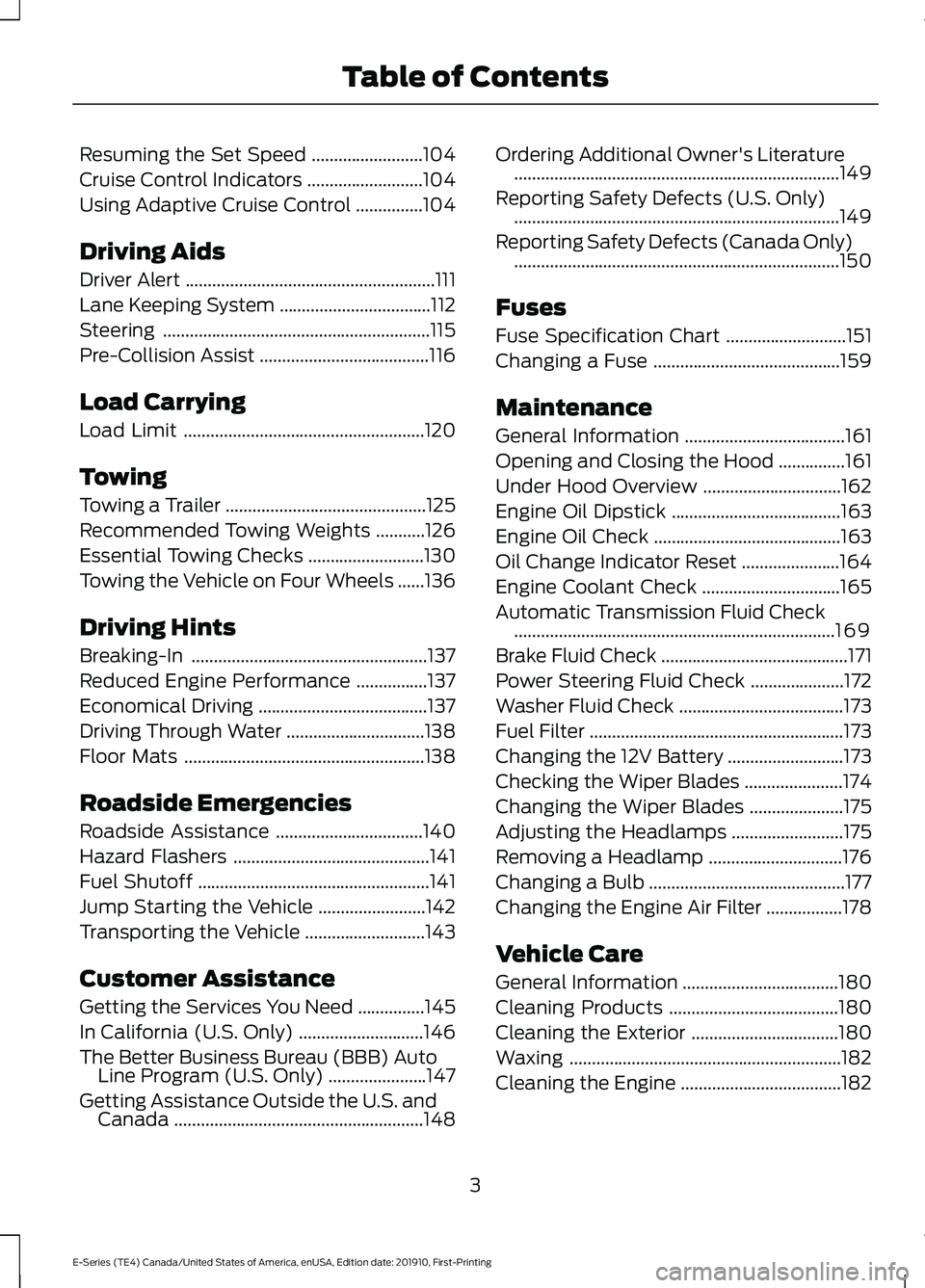
Resuming the Set Speed
.........................104
Cruise Control Indicators ..........................
104
Using Adaptive Cruise Control ...............
104
Driving Aids
Driver Alert ........................................................
111
Lane Keeping System ..................................
112
Steering ............................................................
115
Pre-Collision Assist ......................................
116
Load Carrying
Load Limit ......................................................
120
Towing
Towing a Trailer .............................................
125
Recommended Towing Weights ...........
126
Essential Towing Checks ..........................
130
Towing the Vehicle on Four Wheels ......
136
Driving Hints
Breaking-In .....................................................
137
Reduced Engine Performance ................
137
Economical Driving ......................................
137
Driving Through Water ...............................
138
Floor Mats ......................................................
138
Roadside Emergencies
Roadside Assistance .................................
140
Hazard Flashers ............................................
141
Fuel Shutoff ....................................................
141
Jump Starting the Vehicle ........................
142
Transporting the Vehicle ...........................
143
Customer Assistance
Getting the Services You Need ...............
145
In California (U.S. Only) ............................
146
The Better Business Bureau (BBB) Auto Line Program (U.S. Only) ......................
147
Getting Assistance Outside the U.S. and Canada ........................................................
148Ordering Additional Owner's Literature
........................................................................\
.
149
Reporting Safety Defects (U.S. Only) ........................................................................\
.
149
Reporting Safety Defects (Canada Only) ........................................................................\
.
150
Fuses
Fuse Specification Chart ...........................
151
Changing a Fuse ..........................................
159
Maintenance
General Information ....................................
161
Opening and Closing the Hood ...............
161
Under Hood Overview ...............................
162
Engine Oil Dipstick ......................................
163
Engine Oil Check ..........................................
163
Oil Change Indicator Reset ......................
164
Engine Coolant Check ...............................
165
Automatic Transmission Fluid Check ........................................................................\
169
Brake Fluid Check ..........................................
171
Power Steering Fluid Check .....................
172
Washer Fluid Check .....................................
173
Fuel Filter .........................................................
173
Changing the 12V Battery ..........................
173
Checking the Wiper Blades ......................
174
Changing the Wiper Blades .....................
175
Adjusting the Headlamps .........................
175
Removing a Headlamp ..............................
176
Changing a Bulb ............................................
177
Changing the Engine Air Filter .................
178
Vehicle Care
General Information ...................................
180
Cleaning Products ......................................
180
Cleaning the Exterior .................................
180
Waxing .............................................................
182
Cleaning the Engine ....................................
182
3
E-Series (TE4) Canada/United States of America, enUSA, Edition date: 201910, First-Printing Table of Contents
Page 101 of 301
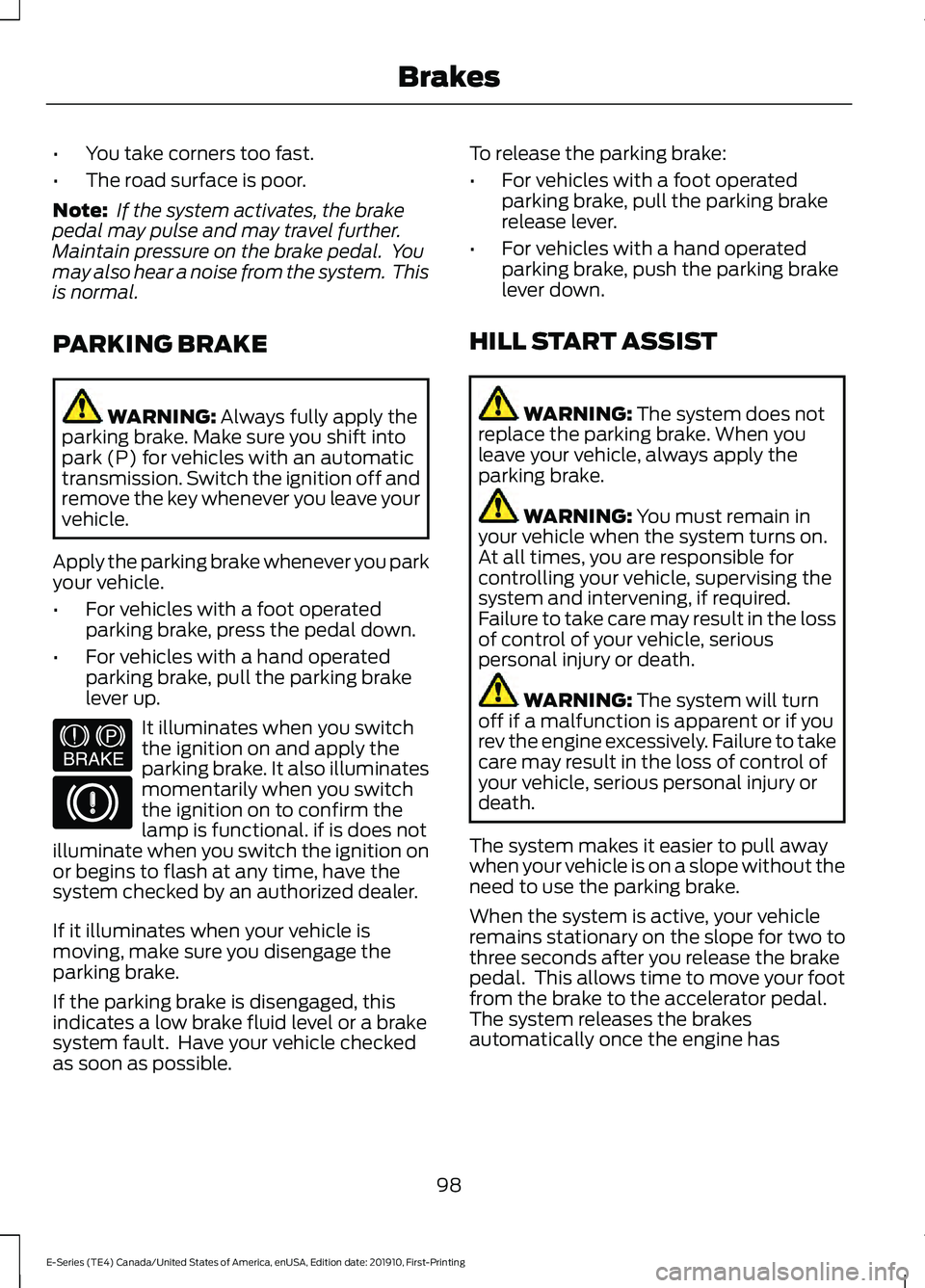
•
You take corners too fast.
• The road surface is poor.
Note: If the system activates, the brake
pedal may pulse and may travel further.
Maintain pressure on the brake pedal. You
may also hear a noise from the system. This
is normal.
PARKING BRAKE WARNING: Always fully apply the
parking brake. Make sure you shift into
park (P) for vehicles with an automatic
transmission. Switch the ignition off and
remove the key whenever you leave your
vehicle.
Apply the parking brake whenever you park
your vehicle.
• For vehicles with a foot operated
parking brake, press the pedal down.
• For vehicles with a hand operated
parking brake, pull the parking brake
lever up. It illuminates when you switch
the ignition on and apply the
parking brake. It also illuminates
momentarily when you switch
the ignition on to confirm the
lamp is functional. if is does not
illuminate when you switch the ignition on
or begins to flash at any time, have the
system checked by an authorized dealer.
If it illuminates when your vehicle is
moving, make sure you disengage the
parking brake.
If the parking brake is disengaged, this
indicates a low brake fluid level or a brake
system fault. Have your vehicle checked
as soon as possible. To release the parking brake:
•
For vehicles with a foot operated
parking brake, pull the parking brake
release lever.
• For vehicles with a hand operated
parking brake, push the parking brake
lever down.
HILL START ASSIST WARNING: The system does not
replace the parking brake. When you
leave your vehicle, always apply the
parking brake. WARNING:
You must remain in
your vehicle when the system turns on.
At all times, you are responsible for
controlling your vehicle, supervising the
system and intervening, if required.
Failure to take care may result in the loss
of control of your vehicle, serious
personal injury or death. WARNING:
The system will turn
off if a malfunction is apparent or if you
rev the engine excessively. Failure to take
care may result in the loss of control of
your vehicle, serious personal injury or
death.
The system makes it easier to pull away
when your vehicle is on a slope without the
need to use the parking brake.
When the system is active, your vehicle
remains stationary on the slope for two to
three seconds after you release the brake
pedal. This allows time to move your foot
from the brake to the accelerator pedal.
The system releases the brakes
automatically once the engine has
98
E-Series (TE4) Canada/United States of America, enUSA, Edition date: 201910, First-Printing BrakesE144522
Page 165 of 301
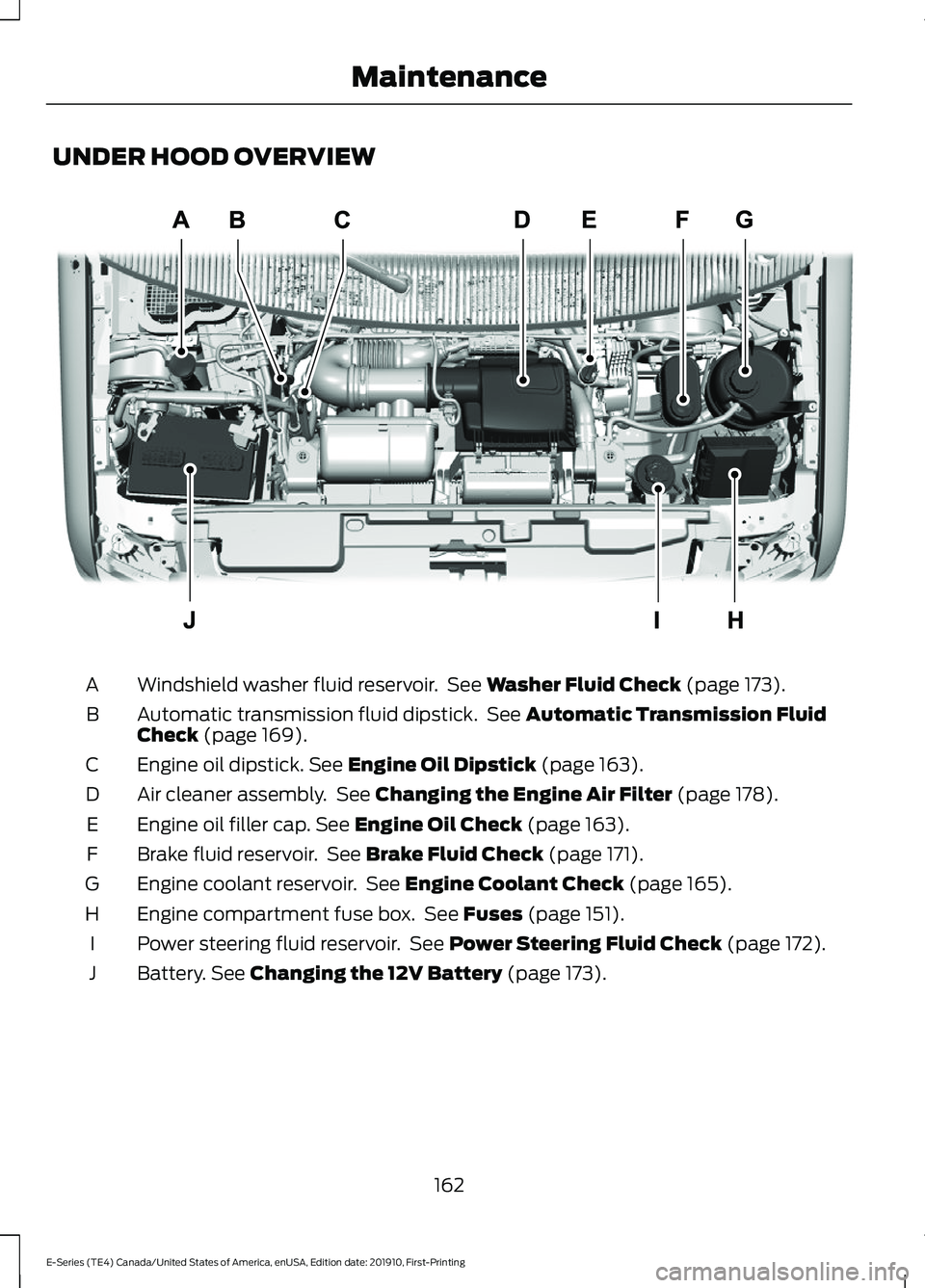
UNDER HOOD OVERVIEW
Windshield washer fluid reservoir. See Washer Fluid Check (page 173).
A
Automatic transmission fluid dipstick. See
Automatic Transmission Fluid
Check (page 169).
B
Engine oil dipstick.
See Engine Oil Dipstick (page 163).
C
Air cleaner assembly. See
Changing the Engine Air Filter (page 178).
D
Engine oil filler cap.
See Engine Oil Check (page 163).
E
Brake fluid reservoir. See
Brake Fluid Check (page 171).
F
Engine coolant reservoir. See
Engine Coolant Check (page 165).
G
Engine compartment fuse box. See
Fuses (page 151).
H
Power steering fluid reservoir. See
Power Steering Fluid Check (page 172).
I
Battery.
See Changing the 12V Battery (page 173).
J
162
E-Series (TE4) Canada/United States of America, enUSA, Edition date: 201910, First-Printing MaintenanceE312299
Page 172 of 301

You may notice a reduction in vehicle
speed caused by reduced engine power in
order to manage the engine coolant
temperature. Your vehicle may enter this
mode if certain high-temperature and
high-load conditions take place. The
amount of speed reduction depends on
vehicle loading, grade and ambient
temperature. If this occurs, there is no need
to pull off the road. You can continue to
drive your vehicle.
The air conditioning may automatically
turn on and off during severe operating
conditions to protect the engine from
overheating. When the coolant
temperature decreases to the normal
operating temperature, the air conditioning
turns on.
If the coolant temperature gauge moves
fully into the red zone, or if the coolant
temperature warning or service engine
soon messages appear in your information
display, do the following:
1. Pull off the road as soon as safely
possible and shift the transmission into
park (P).
2. Leave the engine running until the coolant temperature gauge needle
returns to the normal position. If the
temperature does not drop after
several minutes, follow the remaining
steps.
3. Switch the engine off and wait for it to
cool. Check the coolant level.
4. If the coolant level is at or below the minimum mark, immediately add
prediluted coolant.
5. If the coolant level is normal, restart the engine and continue driving. AUTOMATIC TRANSMISSION
FLUID CHECK
Have an authorized dealer check and
change the transmission fluid and filter at
the correct service interval. See
Scheduled Maintenance (page 250).
Do not use supplemental transmission
fluid additives, treatments or cleaning
agents. The use of these materials may
affect transmission operation and result
in damage to internal transmission
components.
Checking Automatic Transmission
Fluid
For scheduled intervals of the fluid checks
and changes, See
Scheduled
Maintenance (page 250). Your
transmission does not consume fluid.
However, if the transmission is not working
properly, for example, if the transmission
slips or shifts slowly, or if you notice some
sign of fluid leakage, check the fluid level
as soon as possible.
Automatic transmission fluid expands
when warmed. To obtain an accurate fluid
check, drive the vehicle until it is at normal
operating temperature, approximately
19 mi (30 km). Verify that the transmission
fluid temperature gauge on the instrument
cluster is within normal range.
1. Drive the vehicle
19 mi (30 km) until it
reaches normal operating temperature.
2. Park the vehicle on a level surface and
engage the parking brake.
3. With the engine running, parking brake
engaged and your foot on the brake
pedal, move the gearshift lever through
all of the gear ranges. Allow sufficient
time for each gear to engage.
4. Put the transmission in park (P) and leave the engine running.
169
E-Series (TE4) Canada/United States of America, enUSA, Edition date: 201910, First-Printing Maintenance
Page 173 of 301
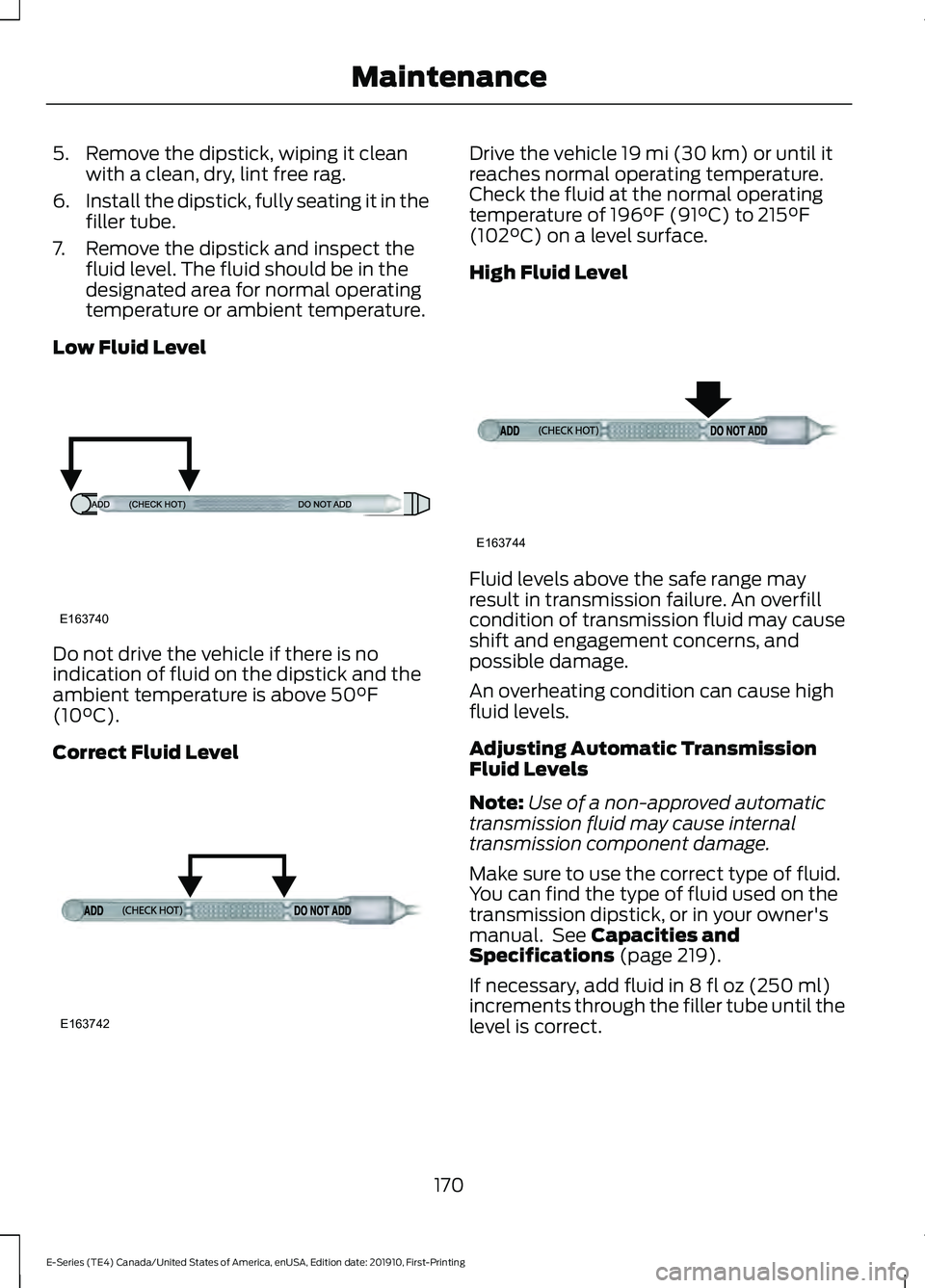
5. Remove the dipstick, wiping it clean
with a clean, dry, lint free rag.
6. Install the dipstick, fully seating it in the
filler tube.
7. Remove the dipstick and inspect the fluid level. The fluid should be in the
designated area for normal operating
temperature or ambient temperature.
Low Fluid Level Do not drive the vehicle if there is no
indication of fluid on the dipstick and the
ambient temperature is above 50°F
(10°C).
Correct Fluid Level Drive the vehicle
19 mi (30 km) or until it
reaches normal operating temperature.
Check the fluid at the normal operating
temperature of
196°F (91°C) to 215°F
(102°C) on a level surface.
High Fluid Level Fluid levels above the safe range may
result in transmission failure. An overfill
condition of transmission fluid may cause
shift and engagement concerns, and
possible damage.
An overheating condition can cause high
fluid levels.
Adjusting Automatic Transmission
Fluid Levels
Note:
Use of a non-approved automatic
transmission fluid may cause internal
transmission component damage.
Make sure to use the correct type of fluid.
You can find the type of fluid used on the
transmission dipstick, or in your owner's
manual. See
Capacities and
Specifications (page 219).
If necessary, add fluid in
8 fl oz (250 ml)
increments through the filler tube until the
level is correct.
170
E-Series (TE4) Canada/United States of America, enUSA, Edition date: 201910, First-Printing MaintenanceE163740 E163742 E163744
Page 174 of 301
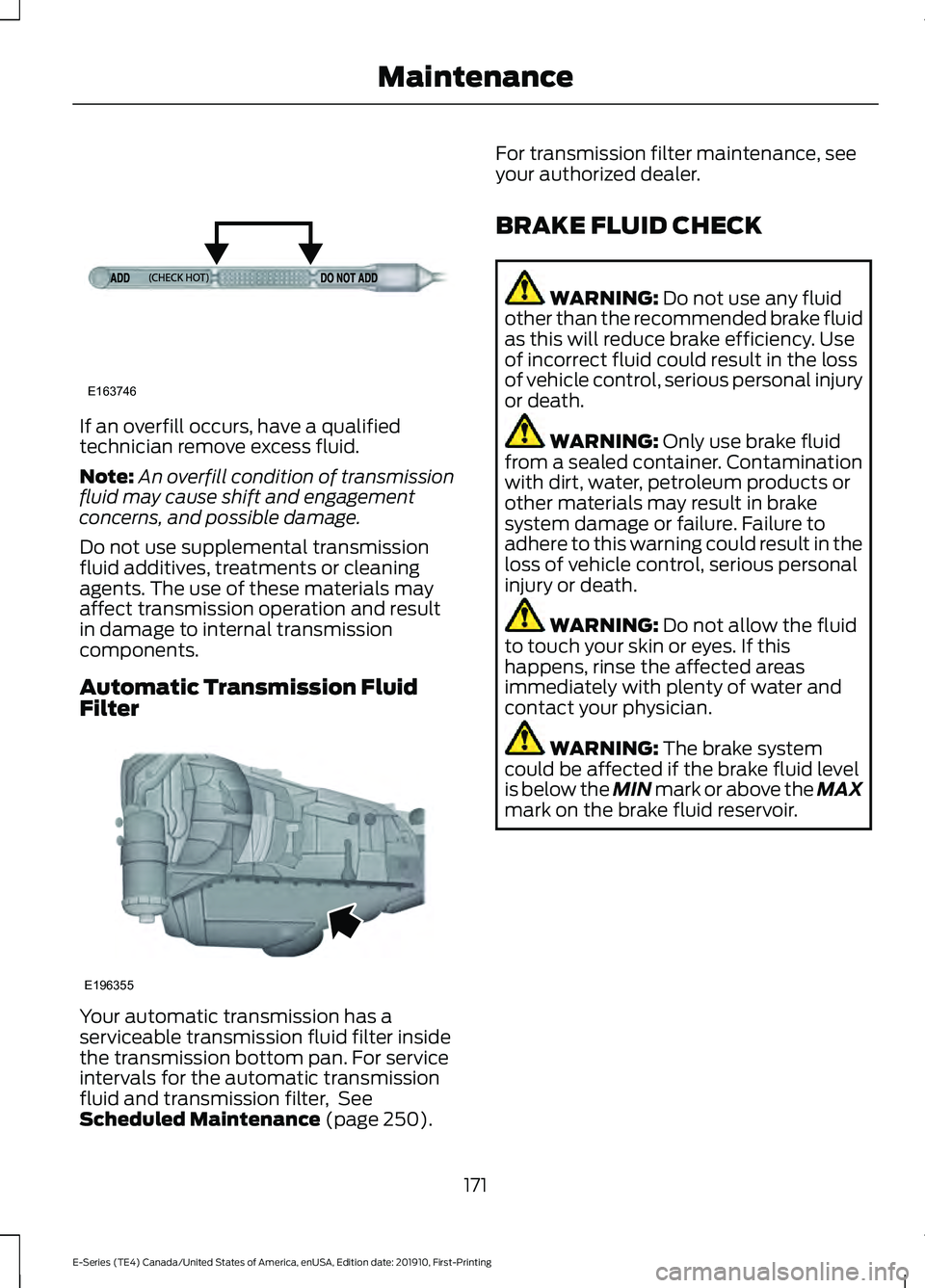
If an overfill occurs, have a qualified
technician remove excess fluid.
Note:
An overfill condition of transmission
fluid may cause shift and engagement
concerns, and possible damage.
Do not use supplemental transmission
fluid additives, treatments or cleaning
agents. The use of these materials may
affect transmission operation and result
in damage to internal transmission
components.
Automatic Transmission Fluid
Filter Your automatic transmission has a
serviceable transmission fluid filter inside
the transmission bottom pan. For service
intervals for the automatic transmission
fluid and transmission filter, See
Scheduled Maintenance (page 250). For transmission filter maintenance, see
your authorized dealer.
BRAKE FLUID CHECK
WARNING:
Do not use any fluid
other than the recommended brake fluid
as this will reduce brake efficiency. Use
of incorrect fluid could result in the loss
of vehicle control, serious personal injury
or death. WARNING:
Only use brake fluid
from a sealed container. Contamination
with dirt, water, petroleum products or
other materials may result in brake
system damage or failure. Failure to
adhere to this warning could result in the
loss of vehicle control, serious personal
injury or death. WARNING:
Do not allow the fluid
to touch your skin or eyes. If this
happens, rinse the affected areas
immediately with plenty of water and
contact your physician. WARNING:
The brake system
could be affected if the brake fluid level
is below the MIN mark or above the MAX
mark on the brake fluid reservoir.
171
E-Series (TE4) Canada/United States of America, enUSA, Edition date: 201910, First-Printing MaintenanceE163746 E196355
Page 226 of 301
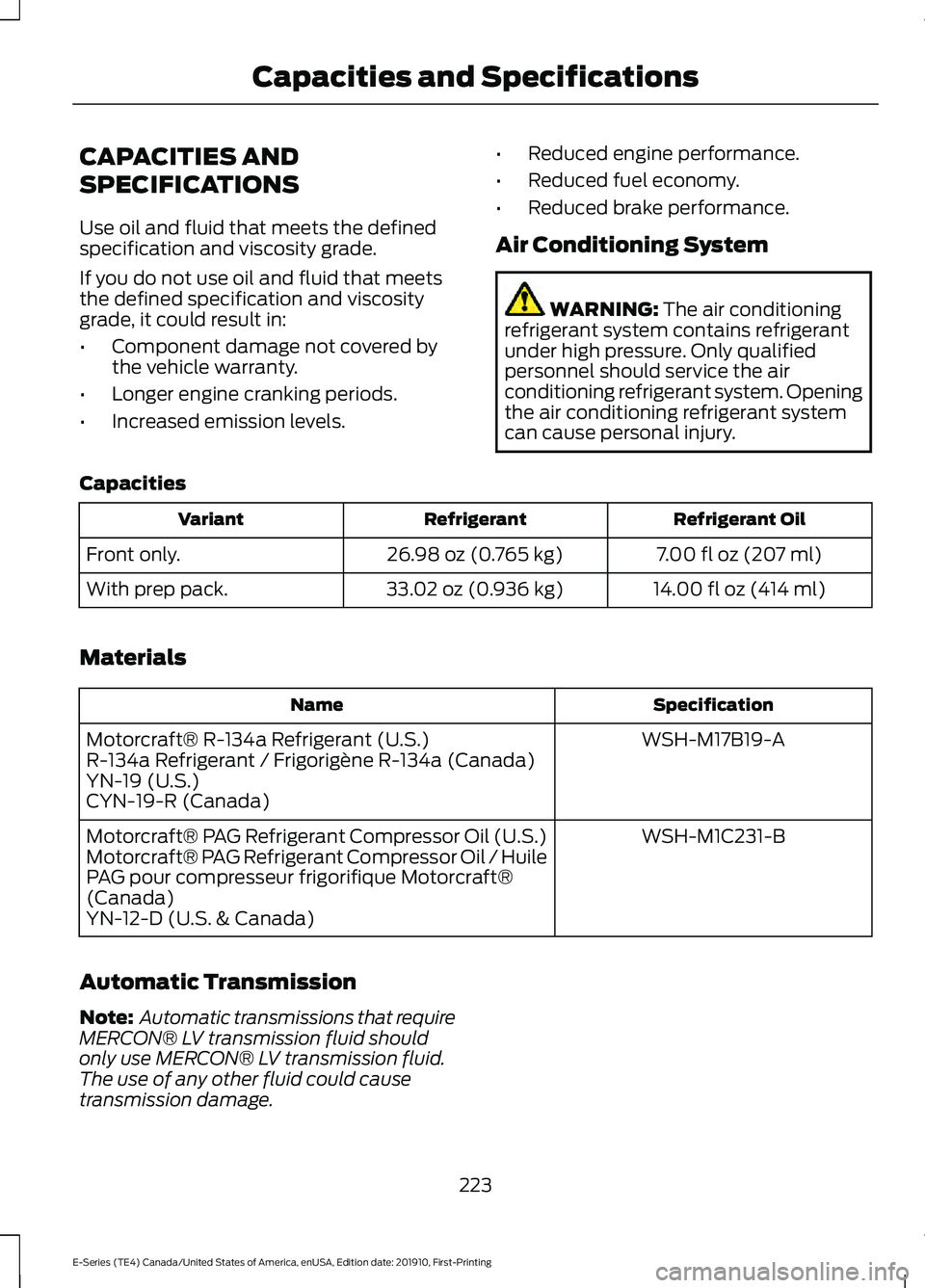
CAPACITIES AND
SPECIFICATIONS
Use oil and fluid that meets the defined
specification and viscosity grade.
If you do not use oil and fluid that meets
the defined specification and viscosity
grade, it could result in:
•
Component damage not covered by
the vehicle warranty.
• Longer engine cranking periods.
• Increased emission levels. •
Reduced engine performance.
• Reduced fuel economy.
• Reduced brake performance.
Air Conditioning System WARNING: The air conditioning
refrigerant system contains refrigerant
under high pressure. Only qualified
personnel should service the air
conditioning refrigerant system. Opening
the air conditioning refrigerant system
can cause personal injury.
Capacities Refrigerant Oil
Refrigerant
Variant
7.00 fl oz (207 ml)
26.98 oz (0.765 kg)
Front only.
14.00 fl oz (414 ml)
33.02 oz (0.936 kg)
With prep pack.
Materials Specification
Name
WSH-M17B19-A
Motorcraft® R-134a Refrigerant (U.S.)
R-134a Refrigerant / Frigorigène R-134a (Canada)
YN-19 (U.S.)
CYN-19-R (Canada)
WSH-M1C231-B
Motorcraft® PAG Refrigerant Compressor Oil (U.S.)
Motorcraft® PAG Refrigerant Compressor Oil / Huile
PAG pour compresseur frigorifique Motorcraft®
(Canada)
YN-12-D (U.S. & Canada)
Automatic Transmission
Note: Automatic transmissions that require
MERCON® LV transmission fluid should
only use MERCON® LV transmission fluid.
The use of any other fluid could cause
transmission damage.
223
E-Series (TE4) Canada/United States of America, enUSA, Edition date: 201910, First-Printing Capacities and Specifications
Page 227 of 301

Capacities
Quantity
Variant
17.4 qt (16.5 L)1
All.
1 Approximate dry fill capacity. Actual amount could vary during fluid changes.
Materials Specification
Name
MERCON® LV WSS-M2C938-A
Motorcraft® MERCON® LV Automatic Transmission
Fluid (U.S.)
Motorcraft® MERCON® LV Automatic Transmission
Fluid / Huile pour boîte automatique MERCON® LV
Motorcraft® (Canada)
XT-10-QLVC (U.S.)
CXT-10-LV6 (Canada)
Engine Coolant
Capacities Quantity
Variant
20.0 qt (18.9 L)
All.
Materials Specification
Name
WSS-M97B57-A2
Motorcraft® Yellow Prediluted Antifreeze/Coolant
(U.S.)
Motorcraft® Yellow Prediluted Antifreeze/Coolant
/ Antigel/liquide de refroidissement prédilué jaune
Motorcraft® (Canada)
VC-13DL-G (U.S.)
CVC-13DL-G (Canada)
224
E-Series (TE4) Canada/United States of America, enUSA, Edition date: 201910, First-Printing Capacities and Specifications
Page 232 of 301
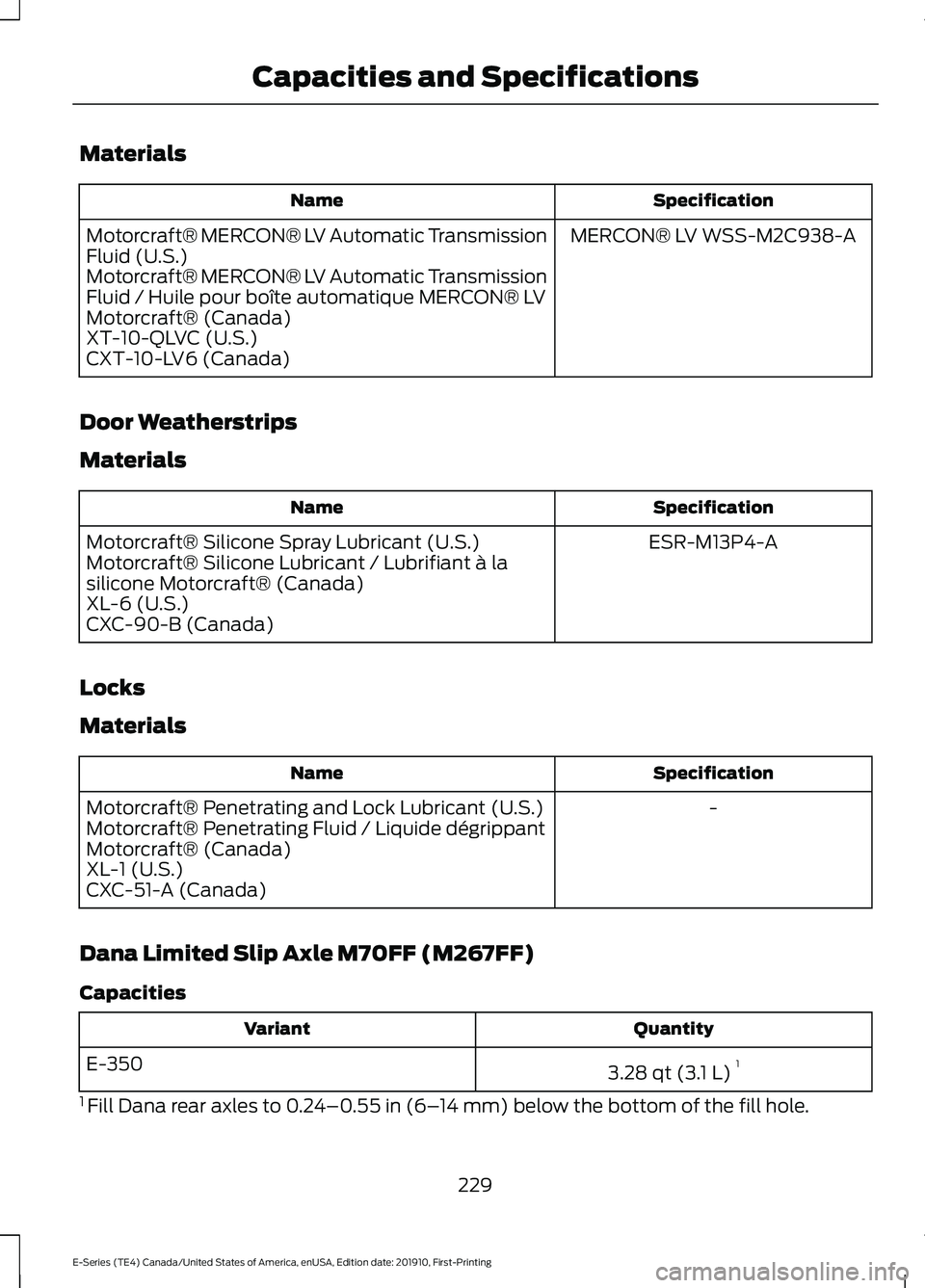
Materials
Specification
Name
MERCON® LV WSS-M2C938-A
Motorcraft® MERCON® LV Automatic Transmission
Fluid (U.S.)
Motorcraft® MERCON® LV Automatic Transmission
Fluid / Huile pour boîte automatique MERCON® LV
Motorcraft® (Canada)
XT-10-QLVC (U.S.)
CXT-10-LV6 (Canada)
Door Weatherstrips
Materials Specification
Name
ESR-M13P4-A
Motorcraft® Silicone Spray Lubricant (U.S.)
Motorcraft® Silicone Lubricant / Lubrifiant à la
silicone Motorcraft® (Canada)
XL-6 (U.S.)
CXC-90-B (Canada)
Locks
Materials Specification
Name
-
Motorcraft® Penetrating and Lock Lubricant (U.S.)
Motorcraft® Penetrating Fluid / Liquide dégrippant
Motorcraft® (Canada)
XL-1 (U.S.)
CXC-51-A (Canada)
Dana Limited Slip Axle M70FF (M267FF)
Capacities Quantity
Variant
3.28 qt (3.1 L)1
E-350
1 Fill Dana rear axles to 0.24–0.55 in (6– 14 mm) below the bottom of the fill hole.
229
E-Series (TE4) Canada/United States of America, enUSA, Edition date: 201910, First-Printing Capacities and Specifications
Page 255 of 301
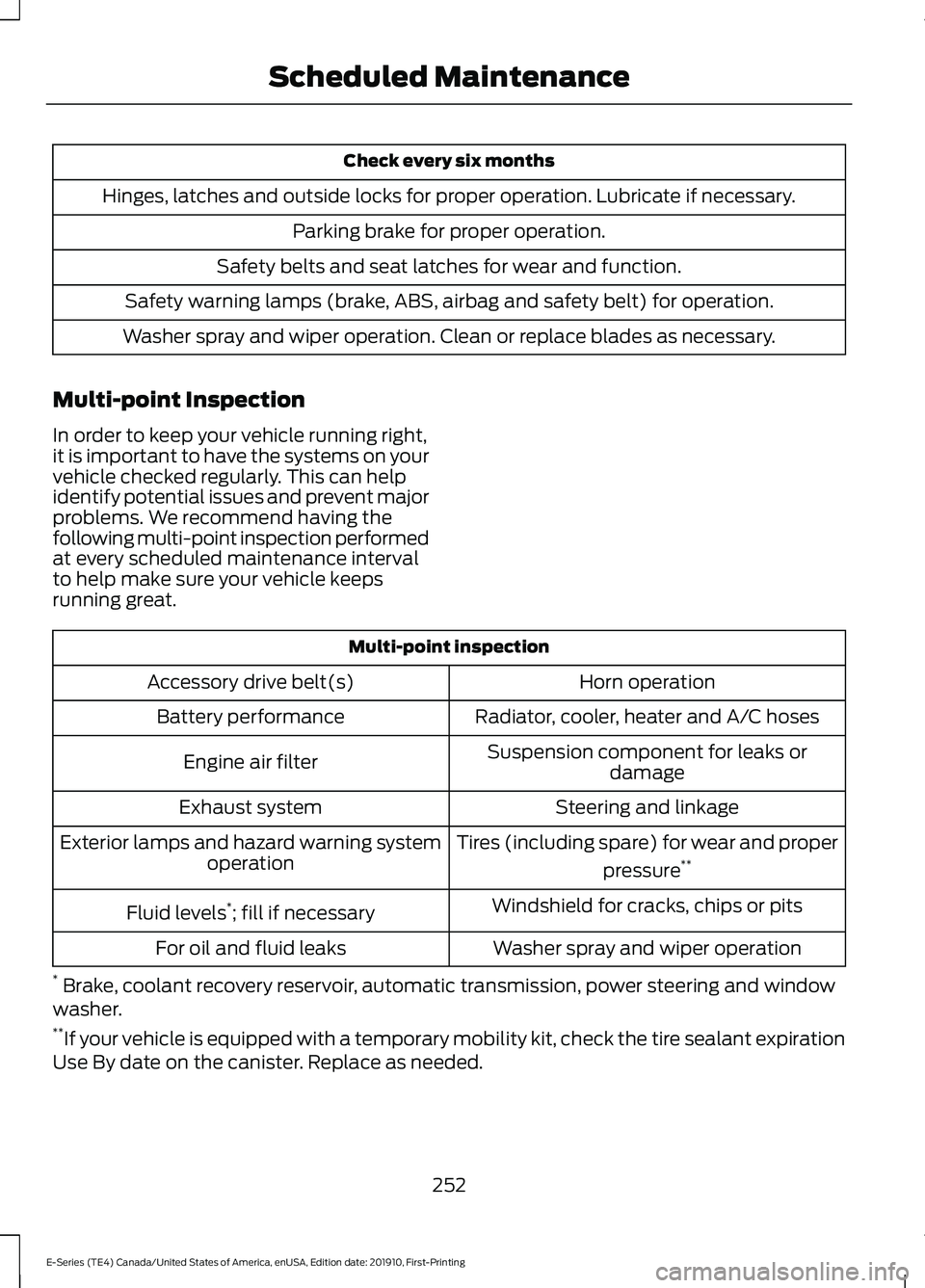
Check every six months
Hinges, latches and outside locks for proper operation. Lubricate if necessary. Parking brake for proper operation.
Safety belts and seat latches for wear and function.
Safety warning lamps (brake, ABS, airbag and safety belt) for operation.
Washer spray and wiper operation. Clean or replace blades as necessary.
Multi-point Inspection
In order to keep your vehicle running right,
it is important to have the systems on your
vehicle checked regularly. This can help
identify potential issues and prevent major
problems. We recommend having the
following multi-point inspection performed
at every scheduled maintenance interval
to help make sure your vehicle keeps
running great. Multi-point inspection
Horn operation
Accessory drive belt(s)
Radiator, cooler, heater and A/C hoses
Battery performance
Suspension component for leaks ordamage
Engine air filter
Steering and linkage
Exhaust system
Tires (including spare) for wear and properpressure**
Exterior lamps and hazard warning system
operation
Windshield for cracks, chips or pits
Fluid levels *
; fill if necessary
Washer spray and wiper operation
For oil and fluid leaks
* Brake, coolant recovery reservoir, automatic transmission, power steering and window
washer.
** If your vehicle is equipped with a temporary mobility kit, check the tire sealant expiration
Use By date on the canister. Replace as needed.
252
E-Series (TE4) Canada/United States of America, enUSA, Edition date: 201910, First-Printing Scheduled Maintenance